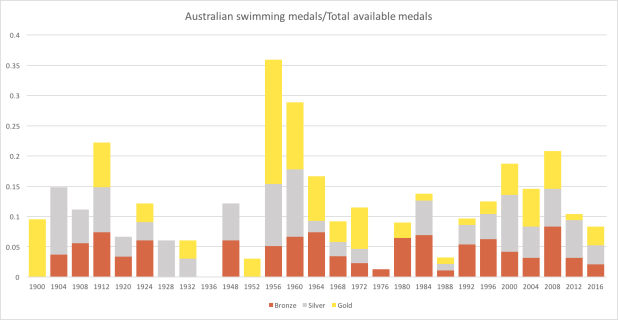If you were to follow the reaction of Australian media after the London Olympic Games, you would have come to the conclusion that the performance of our swimming team was disappointing, to say the least. The “London fiasco”, to use the words featured in the news headlines, was followed by the scrutiny of our athletes’ behaviour prior and during the games. Evidences of a “toxic culture”, which involved the breach of team rules on alcohol, bullying and curfews, were promptly highlighted in the media. But I don’t want to go into the blaming game, the media already did a terrific job with their witch-hunting.
As the Rio 2016 swimming competition comes to an end in a few hours, and we have less medals than in London (we have more golds and, as I write, we still have a couple of chances in the pool today), should we be disappointed again? Well, disappointment is caused by the non-fulfilment of our hopes or expectations, so the question really is: are our expectations realistic? I know that this is a complex question and I’m going to focus on a single issue here, our Olympic medals retrospect.
The graphic below shows our medals in swimming since Paris 1900(1). To make the comparison fair, I divided the number of medals by the total number of medals available (in 1956 there were only 13 swimming events as compared to the current 32(2)). In this way, the number in the vertical axis corresponds to the percentage of medals won by Australia. For example, in St. Louis 1904, Australia won about 15% of the available medals.

Australian Olympic medals in swimming. Numbers are normalised by the total number of medals up for grabs.
Looking at the recent history we can understand the disappointment. Australia had spectacular results (in terms of medal tally) in three consecutive Olympic games: Sydney 2000, Athens 2004 and Beijing 2008. This set the bar pretty high. However, if we go back a little bit, we see that London results are not only on par with the long term average, but also similar to those from the 80’s and 90’s(3).
Note the peak in medal numbers that happened in 1956 and 2000, exactly when Australia hosted the games. This may be an indication that we invested and prepared more for the home games. Interestingly, in both occasions, the numbers remained high for the next two following Olympics (it decayed quickly after Melbourne but was still quite high in 1964), but then went back again to lower levels.
It took me half an hour to get these numbers from the web and plot the graph but I don’t think the TV commentators have done the same exercise. They go with the emotion and tend to expect the best possible outcome from the athletes. When I race I usually set 3 goals: (i) the dream goal – the one that I would achieve if everything is absolutely perfect; (ii) the realistic goal – the one that I would be very happy with and is consistent with my training; (iii) the pessimistic goal – when things go wrong but I would still be OK with it. Anything under (iii) is a total disappointment, above (i) and I’m over the moon.
I believe that the elite athletes have a similar approach and that Swimming Australia has its own goals for the whole team (and it doesn’t need to be in terms of medals, could be number of athletes reaching finals, for example), but it is that being communicated to the media? We can’t only blame the journalists. It would be much easier to manage media and public expectations if the sports associations fed the information to them rather then letting them create their own fantasies based on previous best-case scenarios.
(1) Source: http://corporate.olympics.com.au/sports/swimming/medals
(2) 1956: 7 male events and 6 female events. Since 1996: 16 events for each gender. Source: https://en.wikipedia.org/wiki/Swimming_at_the_Summer_Olympics
(3) Remember that the 1980 and 1984 numbers were probably affected by US and USSR boycotts.